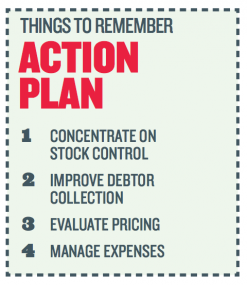How To Improve Your Cashflow #2
 There are many ways to generate positive cash flow – starting with being upfront with customers. The aim is to keep the money moving
your way, rather than subsidising someone else’s business.
There are many ways to generate positive cash flow – starting with being upfront with customers. The aim is to keep the money moving
your way, rather than subsidising someone else’s business.
Once you have completed a cash flow budget it will be apparent as to how much cash you will need, when you will need it and why you need it. You may find that you will generate sufficient cash each month to meet the bills however others may find that their business is seasonal and has some months quieter than others. An overdraft facility is designed specifically for this purpose, to help pay for every day expenses whilst you wait for the cash to come in.
Some business operators believe there is a stigma associated with having to operate with an overdraft facility and that they are not efficient operators. This could not be further from the truth. Many profitable businesses experience peaks and troughs in their cash flow and need the overdraft facility to carry them through these times.
The cash flow budget can be used to predict these periods and help calculate the amount of overdraft facility needed. Once the limit is set, the business can use the available funds on a revolving basis within the limit. They will only pay interest on the funds they use eg. If an overdraft limit is $100,000 and the business writes a cheque for $25,000 using the overdraft facility they will only pay interest on the $25,000 until it is repaid in full.
Match the life of the loan with the life of the asset

It is not provided to pay for what is known as long term assets. These are things such as cars, office fit out, forklifts, equipment etc. Many businesses get themselves into financial trouble because they buy long term assets (they may not be able to afford) by using their overdraft facility.
This often uses up a portion of the overdraft facility not accounted for when the limit was set. This is fine when the overdraft funds are not required but when they are the business can come to a sudden halt. It is best to match the life of the asset with the life of the loan.
This means long term assets are funded using different types of loans such as leasing and business development loans. Speak to your bank and your accountant about what’s the best loan structure for you.
Impact of growth on cash flow

As businesses experience rapid growth they are constantly looking to add more services or stock on the shelf to keep up with demand. This demand tends to consume all available cash and a capital injection is often required to support the growth. History shows that it is difficult for a business experiencing such growth to generate sufficient cash internally and may need to look outside of the business for support.
There are four key ways that the funding can be sourced. Operators can look for new equity from an outside investor. This involves giving up ownership but could improve expertise. They can use net profits, which is often a limited source of funds and only a percentage of that required. They can use trade creditors within the given terms but again is a limited source of funds and finally they can go a bank. Among other things a cash flow budget will help support your case for growth and the need for additional funding.
Stock control

An existing business faces the same issues except that they have previous trade results to help predict the demand for the following year. These results can be adjusted in line with assumptions about expected changes moving forward and understanding what impacted the business last year.
Some operators tend to hoard stock regardless of how useless and unsaleable it is. They can’t help themselves. It is important to understand what the real cost of this stock is to your business and how much cash is tied up in the working capital cycle. Sometimes there is a competitive advantage in being able to provide the right product at the right time but if the stock is old and not needed the golden rule is to get rid of it. Recoup the cash as best you can such as have a sale and inject it back into the business.
Look at what your product mix is, some stock will turn over faster than other items and in general these will have a lower margin but much higher volume. Other items may turn over more slowly but will make a much higher margin.
Buy what you need not what you want. Set up a system that manages stock. This may be having one person responsible for ordering or a
centralised computer program. Check all stock against the invoices to make sure what you order is what you get and record when it should be
paid
for and any discounts available.
Want to learn more?
 Please click on the links below to view our 4 part series on "How To Improve Your Cashflow"
Please click on the links below to view our 4 part series on "How To Improve Your Cashflow"
How To Improve Your Cashflow #1
How To Improve Your Cashflow #2
How To Improve Your Cashflow #3
How To Improve Your Cashflow #4














